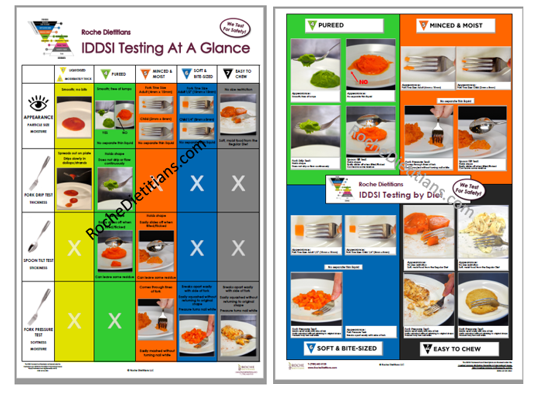IDDSI posters build IDDSI safety culture and train your team on testing
If you’re a dietitian, dietary manager, or speech-language pathologist implementing IDDSI, you know your organization’s kitchen is your IDDSI headquarters.
And you've probably noticed something about your kitchen: it needs a way to reinforce IDDSI concepts.
The best route for reminding your team of IDDSI concepts is using posters. The problem is, you already have countless posters on the walls. Do you genuinely need more?
We’re in favor of using IDDSI posters because they can be a dynamic training tool for your hospital or long-term care facility.
You’ll use these posters to train your team on IDDSI testing methods, reinforce training concepts, and develop a culture of safety.
IDDSI posters aren’t a rudimentary transfer of facts. They’re the cornerstone of building safety culture among your organization’s food service workers.
Ultimately, they help improve your patients’ and residents' safety.
Let’s dive into how to make it happen. In this article, we’re going to cover:
How to harness the visual nature of IDDSI to train your team.
The connection between hospitals, long-term care facilities, and safety culture.
A practical example of developing safety culture with posters.
The first step to creating IDDSI safety culture in your hospital or long-term care facility.
Why our IDDSI posters focus on testing methods.
READ MORE: Your Ultimate Guide to IDDSI
How do you leverage the visual nature of IDDSI? Use posters to train your team.
There’s no doubt IDDSI, or the International Dysphagia Diet Standardisation Initiative, is highly visual.
Take the visual nature of the IDDSI framework. Each IDDSI level has a distinct color, number, and place on the framework.
IDDSI testing methods are also visually oriented. From the fork drip test and spoon tilt test to the fork pressure test and IDDSI flow test, visuals are the foundation of the IDDSI testing methods.
Since IDDSI is so visual, image-based training tools like posters are vital.
Every time a team member sees the IDDSI framework on a poster, they have another opportunity to understand IDDSI better.
READ MORE: Our IDDSI Training Program Is the IDDSI Help You’ve Been Looking For
How do you cultivate IDDSI safety culture in your organization?
Your team members will quickly get used to seeing IDDSI posters in your kitchen.
Soon, something essential will happen: IDDSI will become a part of your kitchen’s safety culture.
By “safety culture,” we mean safety is integral to how your organization thinks and behaves.
We can borrow from the concept of safety culture in the industrial safety business. In high-hazard sectors like construction, manufacturing, and warehousing, organizations emphasize a safety mentality among all employees.
Safety culture isn’t simply about executing safe behaviors. It reflects an organization’s entire value system. These businesses universally integrate safety into their operations.
When safety is core to an organization’s DNA, employees are more likely to embrace it. This approach works much better than merely assigning employees safety-oriented tasks.
READ MORE: Margaret Roche Talks Improving Food Quality and Safety with IDDSI on The Boelter Wire Podcast
What’s a real-life example of safety culture?
So how do you cultivate safety culture in your organization? Let’s look at an example from the industrial safety business.
Most of us have probably seen a warehouse sign that reads, ”It’s been ___ days since an accident.”
The board may seem like a minor addition to the warehouse wall, yet it develops safety culture in several ways.
First, the board is a visual reminder that warehouse employees should do their part to prevent accidents.
Also, when the warehouse manager places it in a prominent location, it shows the organization highly values safety.
Most of all, the board promotes buy-in among warehouse employees to commit to safety culture.
Employees have to work both individually and as a team to keep the board from saying that troubling phrase: "It’s been 0 days since an accident.” The sign incentivizes employees to sustain safety culture every time they see it.
Bottom line: the sign isn’t a mere transfer of information about how many days have passed since an accident happened. It’s a key ingredient to promoting safety culture.
READ MORE: The Five Key Components You Need to Train Food Service Workers on IDDSI
How do you put IDDSI safety culture into action with posters?
The same ideas apply to developing IDDSI safety culture in hospitals, long-term care facilities, and other organizations that work with IDDSI.
However, instead of using signs that read, ”It’s been ___ days since an accident,” we use IDDSI posters that show photos of the IDDSI levels and testing methods.
IDDSI posters don’t just communicate IDDSI information. They’re a visual reminder of your organization’s values.
The reality is we have limited space on our kitchen walls. When you use IDDSI posters, it communicates you care about IDDSI so much it gets real estate on your minimal wall space.
Above all, culture has two components: values and behaviors. Safety is both a value we all embrace and behaviors we all carry out. To uphold these values and behaviors, we recognize we each play a role in helping keep our patients and residents safe.
The ultimate purpose of IDDSI is to reduce our patients’ and residents’ risk of choking. To underscore this purpose, we created IDDSI posters that emphasize the message, “We test for safety.” (Read more about our posters in the next section.)
By including the concept of “We test for safety” in IDDSI training, we start to build safety culture. This message makes our posters different from any other IDDSI posters.
Moreover, highlighting the theme of “We test for safety” may help support your organization’s overall patient safety program.
In addition to underlining your organization’s safety-aligned values and behaviors, posters also reinforce the image-oriented nature of the IDDSI framework, including each level’s color, number, and location on the graphic.
IDDSI is complex, so the more you can show what each level should look like, the better. Posters give a literal snapshot of each level’s appearance.
All these pieces work together to develop IDDSI safety culture among your team.
Consider this under-the-radar truth about safety culture: The most effective way to train employees on an unfamiliar concept is to create a new group culture.
The “group culture” strategy works better than relaying facts in a PowerPoint presentation.
This dynamic occurs with all types of training. However, it especially happens with IDDSI training for two reasons: (1) IDDSI is complicated, and (2) implementing it improperly can cause potentially grievous consequences.
IDDSI posters foster a culture of safety among your team — and help increase your patients’ and residents’ level of safety.
A Place to Find Community Around IDDSI
Where can you find IDDSI testing posters for your team?
A cost-effective first step to creating IDDSI safety culture is getting IDDSI posters that detail the testing methods.
We have two easy-to-read IDDSI posters: IDDSI Testing at a Glance and IDDSI Testing by Level. We’ve also bundled them as an IDDSI Poster Set.
Several IDDSI posters are available online, but our posters are unique because they zero in on IDDSI testing.
Testing is arguably the most challenging part of IDDSI. We’ve broken down the testing methods in two different ways to help your team master them as quickly as possible. Our detailed photos prepared by registered dietitians clarify how to test foods.
Our IDDSI Testing at a Glance poster shows the testing methods for each level, plus pictures of the correct foods. The simplified table gives a bird's eye view of the IDDSI testing methods that correspond with each level.
The companion poster is our IDDSI Testing by Level poster, a quick testing guide with additional photos grouped by level. Your staff will never have to wonder again which testing method they should use for a certain level.
“[Our team] is thankful for quick reference that they can easily double-check their work with. I like that it’s easy to read, colorful, and laminated for easy cleaning.”
“Staff were not as worried about the switch [to IDDSI] after they saw the posters. It’s a good tool to have, especially for new staff.”
“[Before seeing the posters], our culinary staff were not all familiar with the correct Pureed diet characteristics. The picture and description of the consistency was the most beneficial.”

